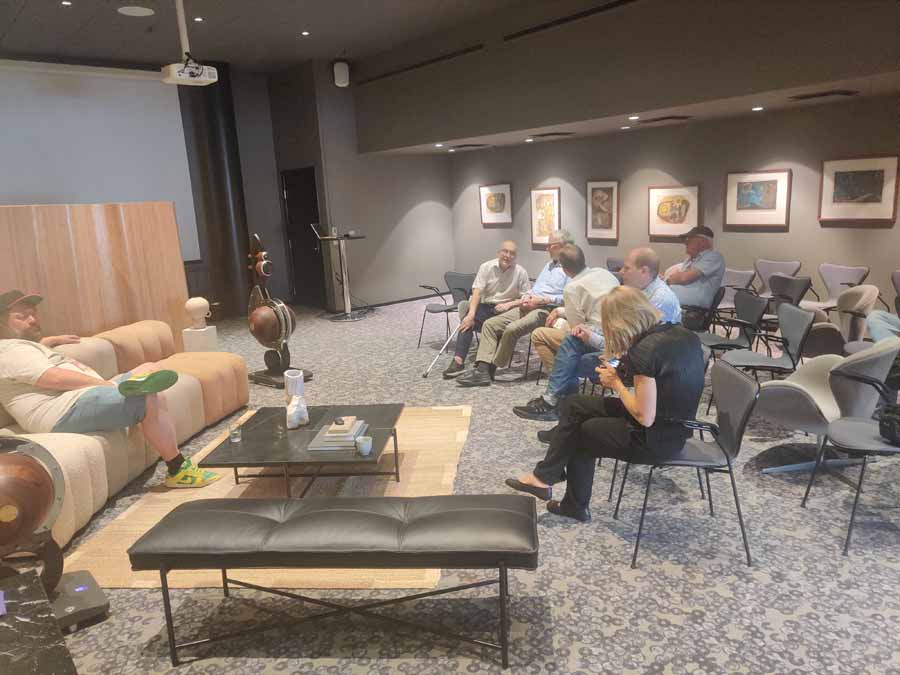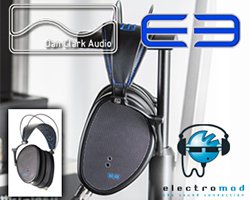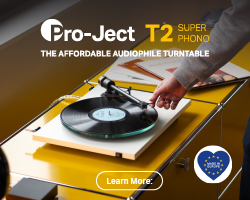AN UNUSUAL SPEAKER SHOWCASED IN AN UNUSUAL LOCATION
HiFi PiG’s Eric van Spelde visited the 3 Days of Design festival in Copenhagen, to meet an extraordinary active speaker system, the Treble Clef Audio TCA-M, and its maker, Ole Siig, among the 300 or so exhibitors spread all over the city.
DANISH DESIGN
Scandinavian design has been widely admired for its elegant simplicity and natural warmth for the past one hundred years or so, and every year Copenhagen finds itself at the epicentre of it all for three days.
Influenced by the Bauhaus school and fuelled by the late industrialisation combined with a tradition of high-quality craftsmanship, Danish design became a force in the early post-war years with many designers seeking to use the new industrial technologies, combined with ideas of simplicity and functionalism to design buildings, furniture and household objects. Prominent examples are Arne Jacobsen´s Egg Chair (1959), Paul Henningsen´s three-shade lamp series (1920s onwards) and Jørn Utzon´s design for the Sidney Opera House (1957). Denmark is also home to famous brands like Dux, Fritz Hansen, Hästens, TechnoGym, Artemide and Bang & Olufsen – all of which were part of the event, be it through having presentations at their stores or special exhibitions in hand-picked locations.
In the middle of it all, a small side room at design studio annex flower shop Tableau at Store Kongsgada in downtown Copenhagen, a very unusual pair of loudspeakers in an equally unusual arrangement inspired by Japanese Zen gardens, was grabbing the attention of passers-by – many of them, as it turned out, having a more than casual relationship with music. “The number of people visiting and the reactions we got through the entirety of the week, were quite overwhelming for our first public event,” says Ole Siig, founder and chief engineer of Treble Clef Audio. “A testament to the collaboration between the craftsmen, engineers and creative team that over the last six years of development have taken to heart the Treble Clef Audio ´Sound by design´ concept, making it into a new brand and approach to home audible, visual and visceral experiences.”
SOUND BY DESIGN
´Sound by design´ is not just another cool sounding, but largely empty slogan coined by some advertising agency exec with little involvement in the actual product, either. “My father, Helge Siig, instilled into me his passion for functionalism,” says Ole Sigg. “During the late 1950s and into the 60s, as a hobby, he created unique furniture that integrated form and function. To this day, I have fond memories of the desk and chair he gifted to me; I spent most of my time with Lego builds and finishing homework here. Eventually, my legs outgrew the desk, but its functional beauty has not been lost.”
“A box is the worst shape to put a speaker in” – Ole Siig, founder and chief engineer, Treble Clef Audio
The Treble Clef Audio speakers´ frame may, indeed, look like, erm, a treble clef (yep, that´s the thingy in front of the notes in a music score to assign a pitch to the base line on this particular score, in this case a G4) which sounds like a design gimmick at first. It´s not, says Siig: the way the speaker looks is entirely founded on acoustic principles, defined by the will to create a dispersion pattern that a) is uniform across the entire frequency range and b) reduces room modes especially in the lower frequency band. “A box – like 99 percent of loudspeaker systems basically have – is literally the worst shape to put a speaker in,” says the designer, “well, except a cylinder perhaps…”
THINKING OUTSIDE THE BOX
“In a full-range speaker system, conventionally the deepest tones demand large box type speakers for adequate bass sound levels. Unfortunately, the larger the speaker enclosure the harder it becomes to prevent vibration and resonant frequencies being transmitted into the room by enclosure surface areas. This extra unintended sound can cause prominent audible sound coloration, which along with strong room interaction obscures the true character of bass. Furthermore, a box design typically leads to midrange and tweeter speaker drivers mounted on the front baffle. Baffle size will limit sound dispersion at higher frequencies narrowing the ´sweet spot´. Through our patented acoustic design, with our speaker there is no such thing as a sweet spot anymore.”
TREBLE CLEF AUDIO TCA-M
Inside the TCA-M´s treble clef-shaped frame are two enclosures of which the outsides are made from selected solid woods. Starting with the low frequency section, The TCA-M patented vibration and resonance cancelling air velocity transducer bass system based on a ´folded dipole´, achieves an exceptionally low bass extension, going down to 16 Hz at -3 dB – which is as low as the very largest organ pipe can reach, from a relatively small enclosure which looks like two upper halves of egg shells placed horizontally with an air gap in the middle. Two 10-inch bass speakers occupy each half, their motor units being seemingly connected by a steel sphere. Bass from a conventional speaker system is omnidirectional, while the dispersion pattern of a dipole is clearly defined as an 8-shape. This, however, is a special kind of dipole, which has an asymmetrical dispersion pattern. It disperses low frequencies to the front, and, with different intensity and 180 degrees reversed phase, to the back. This produces ´antimatter´ at low frequencies which reduces room energy retention effects, primarily standing waves, to great extent. The shape and driver arrangement of the enclosure also has the effect of lowering the natural resonance of the drivers. In fact, the reproduction quality of the lowest notes is being improved, the smaller the cabinet gets(!) – up to a point, which is why the optimum dimensions have to be elaborately calculated, tested and optimised. The problem with a folded dipole (or ´Ripol´) design is that when executed as a box, the upper limit of the usable frequency range is quite low in order to avoid an inherent resonance peak around 150 Hz; too low to couple to a dedicated midrange driver. “With the Treble Clef Audio patented folded dipole principle, the upper frequency range is significantly extended, based on modelling efforts supported by experiments and measurements, such that we can comfortably crossover up to about 220Hz, amply avoiding the inherent folded dipole resonance now occurring at about 370Hz,” explains Siig. “This way a smooth directive transition to a small diameter, high quality midrange system became possible.”
The mid and high frequency transducers are placed in a wooden enclosure consisting of two spheres that end in long, tapered tubes at the rear, not unlike the creations of Lawrence Dickie (B & W, Vivid Audio). The result is a dispersion pattern that is consistent over the entire frequency range. “This also means that the sound reflecting from floors, walls and ceilings is the same as the direct sound from the speaker – which is the way it is with real instruments and voices, but not with sound reproduction from loudspeakers,” says Ole Siig. This is particularly important with the first reflections in a room, which are perceived by the listener as being one with the original sound which normally contributes to a ´thickening´ or ´muddying´ effect.
FULLY ACTIVE LOUDSPEAKERS
The TCA-M speakers are fully active, driven by 1.5 kW of Pascal Audio Class D power (Pascal are incidentally suppliers to Avantgarde Acoustic and Dynaudio, among others, for their (semi-)active speakers) and DSP-controlled over the entire frequency range. “This is integral to the whole Treble Clef Audio concept,” says Siig. “Simply put, it would be impossible to attain the acoustic properties that I wanted to achieve from my research, with passive speakers and different permutations of amplifiers, cables et cetera that are outside my control. Of course, for many, trying out all these permutations in hope to find one´s personal audio nirvana is an exciting part of the audio hobby – at least it was for me, experiencing fleeting moments of greatness but with little concrete explanation as to why and no real consistency. For me as a manufacturer, however, there is no way to guarantee the result that I feel the customer should get from us – a system installed in her or his listening environment which is as transparent to the original recording as it can be. When we set up a pair of TCA-Ms, this is exactly what the customer gets; the DSP setting we end up with can then, be overlaid with a ´digital mask´ of sorts to tailor it to individual listening preferences, music tastes et cetera… The long and short of it, however, that I don´t think it´s feasible to create a loudspeaker system like the TCA-M with the properties we desire, without taking control of the full signal path from inputs to the outputs of several electroacoustic transducers that must act as a single sound source.”
3 DAYS OF DESIGN, COPENHAGEN
We heard the TCA-M in two different locations: first at the press launch at the Copenhagen Radisson Hotel in a large room with high ceilings and what I would call, a more or less classic interior setting, and as part of the 3 Days of Design event in a Japanese Zen Garden installation at art gallery cum flower shop Tableau, where the room was very small and consisted of mainly reflective surfaces.
In both settings, the first thing that strikes you is that, like with real instruments playing, the sound is completely uniform no matter where you sit or stand in the room. As if that weren´t impressive enough alone, the second thing you notice is the bass – or more to the point you don´t notice it because there are no artefacts to reveal there´s a loudspeaker system producing those deep notes rather than a natural sound source, and nor does it at any time – or at any location inside or even outside the venue – seem less than fully integrated with the rest of the frequency band. Another highly interesting aspect of the speaker´s dispersion pattern is its adaptability to various listening situations – from a large soundscape and middle-row-in-a-concert-hall perspective not unlike what larger MBL Radialstrahler speakers offer in the large hotel conference hall to something rather more intimate in the small space of Tableau´s side room. We were not the only ones impressed: drummer Kresten Osgood, one of the leading forces in the Danish jazz scene and beyond, became a convert after hearing the speakers at Siig´s home and held presentations both at the Radisson launch and at Tableau, and among the many people who dropped by in the Zen Garden presentation during the design event, curiosity raised by the sights and sounds, there was an unusually high proportion of musicians, music producers and experienced concert goers who all expressed their surprised and delight of the naturalness of the sound.
Caveats? Well, the front end on both presentations consisted of a Macbook acting as a streaming device and a relatively modest Pioneer preamp, which probably accounted for a slight dryness of the sound in the middle and upper registers that, as it was, weren´t quite up for ultimate expression – although the use of digital sound processing and high-power Class D amplification for all of the frequency range might be a contributing factor also. Quite how far the TCA-M´s (the ´M` in the product designation stands for ´Main´ – surround and centre speakers working according to the same principles to make a complete home theatre system will be added at a later date) capabilities extend into ultra-high end territory in this regard, is hard to say at this point. But make no mistake: this is a breakthrough product at several levels, being possessed with what is probably among the highest levels of temporal and timbral coherence over the entire frequency range and doing it all from an integrated, compact and visually arresting package in real living spaces rather than acoustically optimised sound studios. At around 650,000 Danish Kronar (call it 75,000 euro), of course the TCA-Ms aren´t cheap – but you are buying a one-stop solution, one of which the manufacturer promises it can be updated indefinitely as technology progresses and as an objet d´art and by way of the materials and artisanal rather than industrial build techniques will probably become a family heirloom – so there´s a strong case for declaring them outstanding value for money, too…
Watch this space as we have more to come from Eric’s time with Treble Clef Audio, including an interview with Ole Siig, in our next edition of Not Boring magazine.
Eric van Spelde






















































































































































































